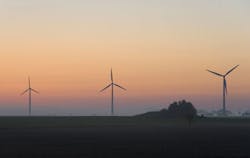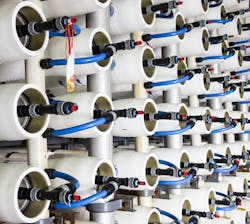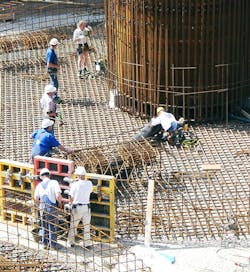As a popular renewable energy, wind power has the potential to help lower the desalination carbon and energy footprint. Yet the coupling of the two industries, for direct wind powered desalination, has not progressed. Why?
By William Steel
As a characteristically energy intensive industry desalination has, historically, relied heavily on fossil fuels. It is estimated that currently installed and operational desalination plants worldwide emit around 76 million tonnes of CO2 per year; an amount expected to grow to around 218 million tons by 2040, according to the Global Clean Water Desalination Alliance (GCWDA).
Change, however, may be on the horizon. With the convergence of heightened calls for clean power production and the advent of technologically advanced renewable energy systems, the feasibility and rationale of powering desalination with clean energy has never been greater.
“Aside from environmental or climate issues, the economics of renewable energy and the costs of power production really suggest that this is the direction desalination should take,” Leon Awerbuch, director of the International Desalination Association tells WWi. “In fact, it’s already the direction we see being taken.”
Desalination processes are powered predominantly by electricity; though a majority of large desalination plants in the Middle East Gulf do operate through thermal processes. Both electricity and heat, however, may be supplied through clean, renewable energy - dramatically lowering desalination operating costs.
Of the methods of renewable energy production available, solar photovoltaics and wind power stand out as the most accessible means of powering desalination. Already the leading source of new renewable energy capacity, wind power is an especially promising route for decarbonising desalination.
Precise economic advantages of wind powered desalination will invariably be project specific as wind turbine power generation is highly dependent on geographic location. However, innovations in the form of wind turbines designed for low wind speed operations are useful in the context of powering desalination - allowing for reliable energy production at wind speeds as low as 3 or 4m/s and available in many regions.
Markus Forstmeier, vice president business development, Electrochaea, but previously involved in researching the feasibility of wind powered desalination while working with GE, tells WWi: “As far back as the middle of the last decade we concluded that wind-powered desalination was cost-competitive with other desalination systems. The economics of these systems are even more favourable today thanks to innovations in the wind industry.”
He adds: “Wind power and desalination would seem a natural fit but it’s somewhat fallen between the cracks of the two industries.”
Remarking on this potential Awerbuch says: “Consider reverse desalination (RO), which is today the most efficient desalination process, using roughly 3.5kW/h per cubic meter of water. If you took just a single 7MW wind turbine, you have power for producing over 48,000 m3 water per day.”
“If you consider some of the wind farms being built today, of hundreds of megawatts in capacity - you could produce a huge amount of water from this, with a cost of energy that fossil fuels cannot compete with.”
Opportunities and challenges in wind
Australia’s Kwinana wind powered desalination plant in Perth was a seminal development when it came online in 2006; the first of its kind, it’s a large scale 140,000 m3/day RO plant, touted as powered by an 80MW wind farm. But while Kwinana - like the Kurnell desalination plant in Sydney - is on paper powered by wind, it’s actually run off electricity from the national grid.
“These plants are purchasing renewable energy certificates to cover their power consumption. In effect, they’re powered by renewables indirectly though the grid,” says Awerbuch.
“If you look at desalination in Australia - every major plant is coupled to wind energy,” says Awerbuch. “These are fantastic examples of indirect use of wind power in desalination plants; but what I’m excited about is finding solutions to use wind power directly.”
Claus Mertes, managing director of desalination consultants DME expands on the direct/indirect distinction; explaining to WWi that there are two methods of coupling wind power and desalination. The first, project integration, is evidenced in Kwinana and Kurnell. “Here operations are designed in such a way that amount of energy used in desalination is grid provided in real time, but is offset (i.e. matched) by wind power generated at some other time,” he says. “In locations with stable grids, this type of system is very achievable and technically feasible as it allows for stable desalination operations.”
However, as Forstmeier observes: “While one could source green energy through the transmission grid, this isn’t always an option, so on-site production of renewable energy is the solution.”
On-site production of renewable energy is what Mertes terms process integration: “This refers to direct coupling between desalination system and wind power; as there’s no grid connection this means that the plant can only operate water when wind power is available.”
Integration
It is process integration of wind power that Awerbuch, Mertes and Forstmeier alike would like to see more of. Unfortunately, there are obstacles to the deployment of process integrated desalination plants. Prominently this is because doubt remains over the feasibility of process integration within the desalination community.
Much of that doubt is grounded in uncertainty over whether desalination systems - irrespective of technology - may be adequately powered through wind power systems.
Awerbuch explains the key challenge in this respect, saying: “One of the unavoidable challenges of coupling wind power - or solar power for that matter - is the intermittent nature of energy production. Usually desalination plants like to be operated with base loaded power, which allows for continuous operation.”
Concern remains in the water industry over the idea of have to shut desalination systems on and off. It’s principally for this reason that conventional power production, project integration, or at the very least retaining of a back-up grid connection, have been favoured.
While the intermittency of wind as an energy resource is inherently unavoidable, and stands in direct conflict with a preference for steady state operations, the problems intermittency creates do hold solutions.
As Forstmeier says: “This is the key conflict but it’s readily overcome.”
First and foremost he observes that: “Some modifications to desalination systems themselves are required if it’s being powered by wind power. These are actually relatively straight-forward changes. For instance the desalination electrical system requires a variable speed drive to accommodate variability in power supply.”
Mertes comments on a related issue, saying process integrated plants require “[Having] a very precise supervisory control and data acquisition (SCADA) system [to monitor wind generation] and operating regime to effectively couple the systems.”
The issue remains, however, that if wind generation is altogether not available, desalination operations may not meet water requirements. There are two broad solutions to this.
One is to increase the desalination capacity such that when power is available a water surplus - relative to planned demand - can be produced and stored.
To this Mertes responds, “Water storage systems aren’t ideal from a financial perspective either. And besides, increasing capacity of your plant carries major CAPEX consequences which aren’t attractive.”
Alternatively, one might expand wind power capacity while designing the desalination plant to rely only on a smaller proportion of this energy capacity.
Forstmeier explains the rationale here: “One could operate, say, ten wind turbines, and use some proportion of their output, as baseload, to power desalination processes, and then only feed fluctuation into the grid. In other words, you’re not designing to 100% of your wind turbines’ idealised output; but something far lower which is available far more frequently and reliably.”
Charging up batteries
There is one further, obvious, solution to intermittency: “Naturally, battery storage would solve these issues,” says Awerbuch. “But while the battery industry has seen rapid development, it’s likely to be quite some time before its a competitive solution to enable steady state operations.”
Ultimately, opting for a wind powered desalination design means increased capital costs - something that’s been a hurdle for encouraging wind powered desalination.
As Forstmeier says, “Incorporating wind power adds considerably to the up-front, capital costs to a desalination project. Of course operating costs are subsequently reduced. This is important because it means that encouraging the desalination industry to adopt wind power requires promoting a change in mind set - it’s about accepting higher CAPEX in place of high operating costs.”
Texas: An ideal candidate for wind powered desal?
Michael Webber, deputy director, Energy Institute at the University of Texas, has conducted significant amounts of research into the use of renewable energy, including wind power, in water treatment systems.
In particular he has reported on Texas as an ideal candidate for wind-powered desalination, on account of “Texas [having] a lot of wind, freshwater scarcity, an isolated grid, a competitive electric market, and abundant brackish groundwater.”
Low water prices and high up-front costs remain the key prohibitive factors for deployment in Texas, where he says “our results have caught the attention of planners and policymakers, but it’s not clear whether any systems will be built.” All told, there appears a clear divide between the relative advantages of wind powered desalination and its deployment. Working to close this divide, collective ambitions to accelerate the decarbonising of desalination industry has led to foundation of the GCWDA last year at COP21.
Notable ambitions are outlined in a recent GCWDA paper - published August 2016. In regards to existing desalination plants, the paper calls for at least 10% of the annual energy demand to be supplied from newly installed clean energy sources by 2030.
For new desalination plants commencing operation between 2020 and 2025, the target is to supply at least 20% of the annual energy demand from newly installed clean energy sources; 40% between 2026 and 2030; 60% between 2031 and 2035; and 80% after 2035.
Floating Desalination
Floating wind power is a relatively novel concept within the wind industry, and commercial projects are only recently coming to fruition. As the name suggests, floating wind replaces fixed-bottom foundation solutions with floating platforms on which turbines are set.
Floating designs are expected to enable access to deeper waters, further out to sea where wind strengths are strong and reliable, but where it’s cost-prohibitive or altogether infeasible to deploy fixed-bottom foundations. Furthermore, floating desalination systems eliminate the need for conventional intake structures. Instead, floating in a location of preference would allow for a deep-water intake. This means lower pre-treatment costs and better quality of seawater easier for RO membrane operation and reduces related costs.
Additional savings would come from subsequent reduced energy requirement, says Awerbuch, adding that effluent concentrate disposal is also easier offshore. In summary, he says, “Significant additional costs can be avoided if you’re floating, and have easy access to deep water.”
Such a concept is certainly promising. However, as with onshore wind powered desalination, it remains to be seen how both industries - wind and desalination alike - might come together and respond to the opportunities before them.
Ultimately, with great growth pitched for global desalination capacity in the near future and the complementary nature of desalination and wind power, integration of these technologies seems not only promising, but a vital part of a sustainable future.
William Steel is a freelance contributor for WWi magazine.
More Water & WasteWater International Archives Issue Articles





